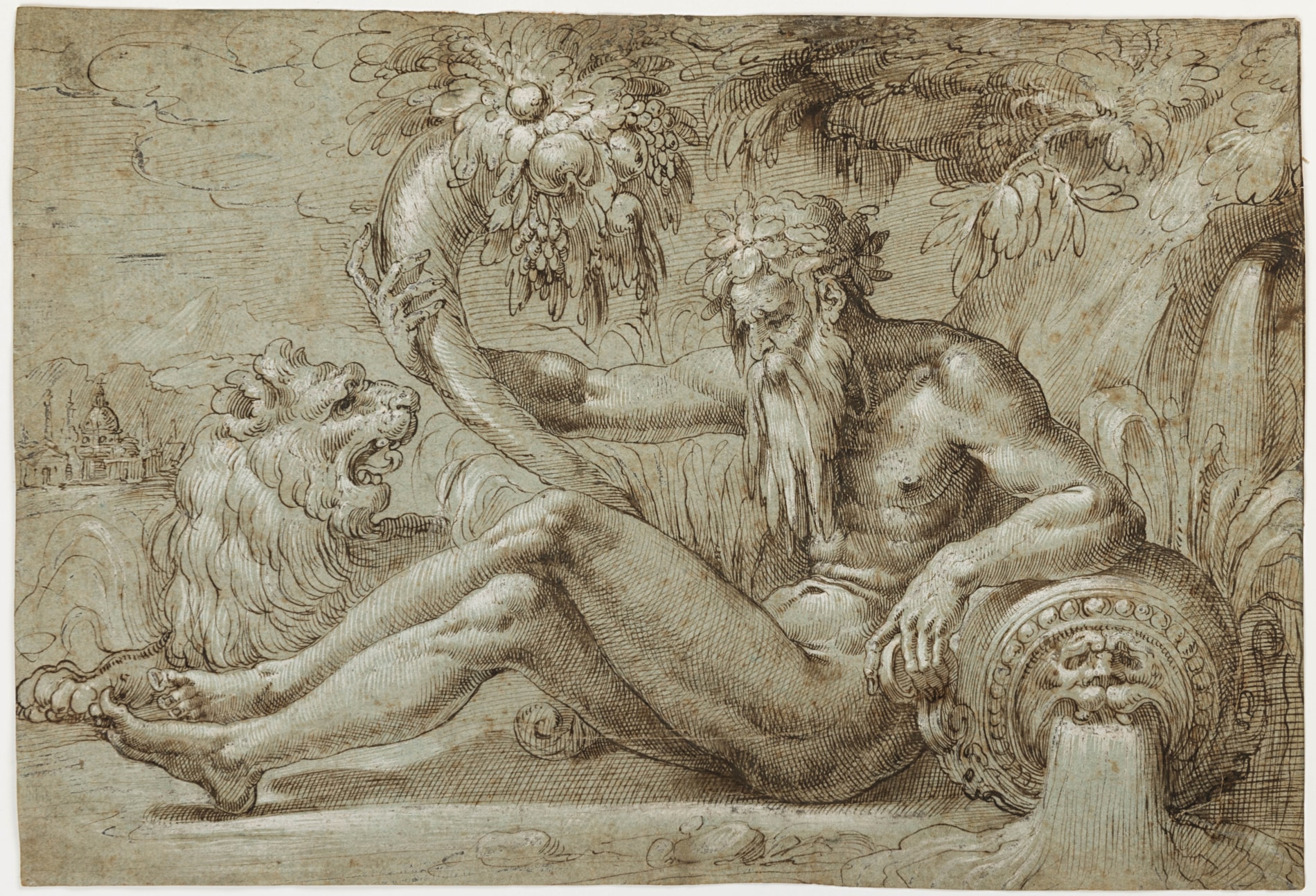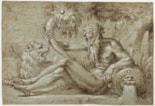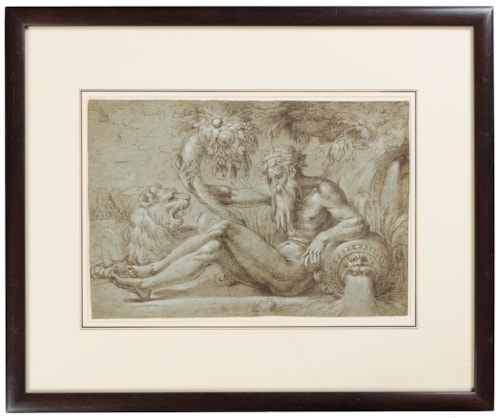Circle of Giorgio VASARI
(Arezzo 1511 - Florence 1574)
The River God Arno with a Cornucopia and a Lion
Pen and brown ink, heightened with white, with traces of a framing line in brown ink, on blue paper.
Inscribed (in a modern hand) FRANCO and Franco ou Farinati in pencil on the verso.
248 x 358 mm. (9 3/4 x 14 1/8 in.)
Inscribed (in a modern hand) FRANCO and Franco ou Farinati in pencil on the verso.
248 x 358 mm. (9 3/4 x 14 1/8 in.)
This large sheet depicts the river god Arno accompanied by the Marzocco, the lion symbolic of the city of Florence, together with a view of what appears to be Florence (or perhaps Rome?) in the distance. Although this fine drawing was attributed to Giorgio Vasari by the scholar A. E. Popham, more recently Florian Härb has pointed out that ‘the dry handling of the pen and its overall flat appearance excludes Vasari’s authorship.’ He suggests, however, that the present sheet, which is datable to the 1540s or 1550s, may be a copy after a lost drawing by Vasari, and further notes that it is similar in type, if not in style, with a number of drawings of river gods by Vasari – in Berlin, Liverpool and Paris - that were studies for the now-lost decoration of a room in a Venetian palace intended to accompany a performance of Pietro Aretino’s play La Talanta in 1542.
Vasari’s decorative scheme for La Talanta was commissioned from the artist in December 1541, during his first visit to Venice, by a group of Venetian noblemen calling themselves the Compagnia della Calza ‘Sempiterni’, who were to perform Aretino’s play during the Carnival. Known as the Apparato dei Sempiterni, the project consisted of wall paintings of allegorical figures of Virtues interspersed with large, monochrome landscapes of Venice and its territories, together with ceiling paintings representing the four times of day and the hours. River gods appeared in several of the wall decorations for La Talanta, and one of these panels depicted the river gods of the Arno, the Tiber and the Appenine together. The present sheet, while not by Vasari himself, closely matches his written description of the Arno river god, in a letter of 1542 to his patron Ottaviano de’ Medici in Florence: ‘on the other wall there was our Arno who had a garland of corn, millet and sorghum, and a cornucopia filled with fruits, holding an open water vessel on a lion, a lily in his hand, he was resting on a lion turning his head towards the Tiber, who was also there…’ Vasari’s letter to Ottaviano de’ Medici, composed immediately after the performance of La Talanta in February 1542, contained a detailed description of the various paintings that made up the Apparato dei Sempiterni. Since the decoration was dismantled shortly afterwards, and is no longer extant, this letter is one of the best records of the appearance of the work, alongside the dozen or so autograph drawings for the project that survive, as well as several copies of lost drawings by Vasari for the same commission.
As Härb notes, with reference to the present sheet, ‘The Apparato included one painting dedicated to a single river god, symbolizing the river Po, the second on the right wall next to the allegory of Venice…It is not inconceivable that the former Brophy sheet reflects an early idea for the decoration, to depict the Arno instead of the Po on its own. However, given the site of the performance, such an emphasis on a Tuscan motif might not have been considered appropriate.’
A drawing of a river god in an almost identical pose, drawn in black and white chalk on blue paper, appeared at auction in London in 1981 with an attribution to Battista Franco (c.1510-1561).
Vasari’s decorative scheme for La Talanta was commissioned from the artist in December 1541, during his first visit to Venice, by a group of Venetian noblemen calling themselves the Compagnia della Calza ‘Sempiterni’, who were to perform Aretino’s play during the Carnival. Known as the Apparato dei Sempiterni, the project consisted of wall paintings of allegorical figures of Virtues interspersed with large, monochrome landscapes of Venice and its territories, together with ceiling paintings representing the four times of day and the hours. River gods appeared in several of the wall decorations for La Talanta, and one of these panels depicted the river gods of the Arno, the Tiber and the Appenine together. The present sheet, while not by Vasari himself, closely matches his written description of the Arno river god, in a letter of 1542 to his patron Ottaviano de’ Medici in Florence: ‘on the other wall there was our Arno who had a garland of corn, millet and sorghum, and a cornucopia filled with fruits, holding an open water vessel on a lion, a lily in his hand, he was resting on a lion turning his head towards the Tiber, who was also there…’ Vasari’s letter to Ottaviano de’ Medici, composed immediately after the performance of La Talanta in February 1542, contained a detailed description of the various paintings that made up the Apparato dei Sempiterni. Since the decoration was dismantled shortly afterwards, and is no longer extant, this letter is one of the best records of the appearance of the work, alongside the dozen or so autograph drawings for the project that survive, as well as several copies of lost drawings by Vasari for the same commission.
As Härb notes, with reference to the present sheet, ‘The Apparato included one painting dedicated to a single river god, symbolizing the river Po, the second on the right wall next to the allegory of Venice…It is not inconceivable that the former Brophy sheet reflects an early idea for the decoration, to depict the Arno instead of the Po on its own. However, given the site of the performance, such an emphasis on a Tuscan motif might not have been considered appropriate.’
A drawing of a river god in an almost identical pose, drawn in black and white chalk on blue paper, appeared at auction in London in 1981 with an attribution to Battista Franco (c.1510-1561).
Provenance
John Brophy, London
Anonymous sale, London, Christie’s, 4 July 1995, lot 163 (as Circle of Giorgio Vasari)
R. S. Johnson Fine Art, Chicago
Private collection.
Anonymous sale, London, Christie’s, 4 July 1995, lot 163 (as Circle of Giorgio Vasari)
R. S. Johnson Fine Art, Chicago
Private collection.
Literature
Horace Wood Brock, Martin P. Levy and Clifford S. Ackley, Splendor and Elegance: European Decorative Arts and Drawings from the Horace Wood Brock Collection, exhibition catalogue, Boston, 2009, p.157, no.115, illustrated p.116 (as Attributed to Marco Marchetti da Faenza); Florian Härb, The Drawings of Giorgio Vasari (1511-1574), Rome, 2015, p.201, under no.56, fig.56.1 (as a copy after Vasari).
Exhibition
Boston, Museum of Fine Arts, Splendor and Elegance: European Decorative Arts and Drawings from the Horace Wood Brock Collection, 2009, no.115.





